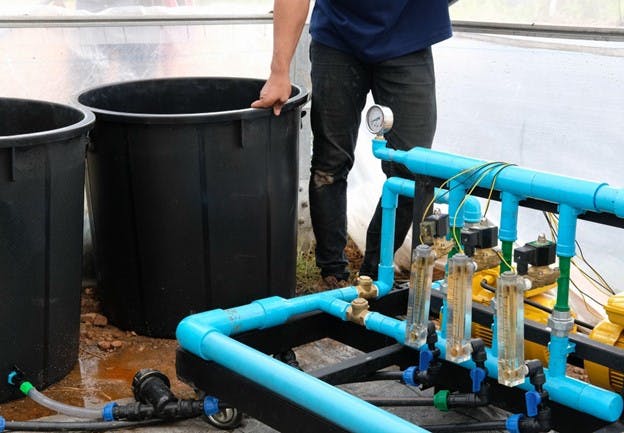February 2024
Understand the Basics of Sustainable Water Management
We all need clean water to survive, but water resources and water quality vary widely from place to place. Sustainable water management involves using laws, technology, and conservation practices to minimize water use and maintain water quality.
The most sustainable water management practices will vary depending on the water sources and climate of the region.
Learn more about sustainable water resource management, and how you can drink water the eco-friendly way—without wrecking the environment.
What Is Sustainable Water Management?
The sustainable management of water resources means ensuring there’s enough water available to meet the daily needs of the people in a region—and for future generations to come. It goes beyond simply reducing water use, and includes measures to protect the water supply, build water infrastructure, and treat or reuse wastewater.
Some of the element of sustainable water management include:
- Conserving water in the home and in municipal water systems
- Protecting the quality of drinking water by limiting water pollution
- Allocating water resources for agriculture and industrial use
- Monitoring the impact of climate change on water security
Sustainable water management involves taking a long-term view, balancing current water demand with the need to ensure sufficient water availability in the future.
Why Is Sustainable Water Management Important?
Water is one of the world’s most important natural resources. According to the World Wildlife Fund, freshwater represents less than 3% of the earth’s water, and an even smaller percentage is available for everyday use.
Although it’s technically a renewable resource, some regions experience significant variability in water resources throughout the year. Water stress occurs when annual water availability falls “below 1700 m³ per person,” and water scarcity occurs when it’s less than “1000 m³ per person.”
Here’s why that matters, and why sustainable water management is important for the environment, human health, and society overall.
Environmental Impact
A watershed is an entire region tied to a particular water system, such as the Mississippi River basin. Sustainable water management involves looking at the entire water cycle in the watershed, not just human consumption. For example, low water levels can impact the ability of salmon to swim upstream or for birds to thrive in wetlands.
Water management also has a role to play in renewable energy generation and can help to lower carbon emissions by replacing fossil fuels with hydroelectric power.
Human Health
One of the U.N.’s 17 Sustainable Development Goals is to “ensure access to water and sanitation for all” due to its key role in human health and hygiene. Water shortages can have immediate impacts on the local populations and can also contribute to long-term challenges with food production and disaster preparedness.
Reducing water consumption can protect water supplies in times of water scarcity, while effective water treatment and sustainable water management helps us avoid the most common waterborne diseases, like cholera and dysentery.
Society
Sustainable water management is partly about self-sufficiency. Regions that take steps to protect their water supplies will be more resilient in the face of floods, droughts, and the impacts of climate change. Water shortages can have geopolitical implications, as neighboring countries compete for scarce water resources.
Individuals can take steps to protect their own water supply by testing their tap water, installing a greywater system, and using whole home water filters.

What Is the Goal of Sustainable Water Management?
The main goal of sustainable water management is to meet the needs of today’s water users while protecting water resources for future use. Sustainable water management involves balancing the interests of domestic water users, industrial and agricultural stakeholders, and the environment itself.
Water management practices tend to focus on the following three water sources:
Groundwater
Groundwater refers to freshwater resources that are located underground, often in an aquifer, a “body of porous rock or sediment saturated with groundwater.” If your home has a private water well, it most likely draws water from an aquifer.
Although aquifers can seem like a never-ending source of water, according to the World Resources Institute, “many of the world’s biggest aquifers are being depleted at a much faster rate than they can be replenished.”
By giving aquifers time to recharge, we can use groundwater sustainably and ensure that there’s sufficient water available for future generations.
Surface Water
Surface water resources are those found above the ground, including freshwater lakes and streams, rainfall, and snowmelt. While dams and reservoirs can be used to store water for future use, they can also damage the environment and disrupt migration.
Surface water can also be contaminated by industrial and agricultural runoff, which is why everything from pharmaceuticals to microplastics are found in drinking water.
Some parts of the country allocate surface water through a system of water rights, in which landowners get access to water sources based on proximity or seniority.
Reclaimed Water
A third type of water is reclaimed water, which refers to water that is used for another purpose after it has already been used once. Water recycling can include everything from home greywater systems to industrial scale water reclamation plants.
Greywater: is any type of non-toilet water (such as water from a washing machine or dishwasher) that can be used for a secondary purpose, such as watering plants.
Black water: is wastewater that isn’t safe for immediate reuse, but even this can be treated and recycled as part of a sustainable water management system.
How Does Sustainable Water Management Contribute to Healthy Ecosystems?
Sustainable water management has several benefits for the environment, both on a global scale and on individual ecosystems. Here are just a few examples:
- Effective water management mitigates aquifer depletion due to overuse by giving groundwater resources time to recharge
- Conserving freshwater resources supports biodiversity by minimizing habitat loss and safeguarding migration routes
- Protecting forests and wetlands allows for flood mitigation and water filtration due the role of plants and animals in the water cycle
- Water reclamation reduces pollution by removing contaminants from wastewater before releasing it into the environment
Municipal governments, agricultural water users, and individuals all have a role to play in reducing their water consumption and minimizing water pollution.

Which Technologies Support Sustainable Water Management?
Water conservation practices have come a long way from simply turning off the faucet while brushing your teeth. From new technologies to large-scale water infrastructure projects, here are some of the keys to sustainable water management:
Water Meters
Reducing water consumption starts with knowing how much water you’re using. Smart water meters can help you track your water use, identify leaks, and save water at home. Smart meters are especially useful in agriculture, where precision irrigation techniques allow farmers to use just the right amount of water for each crop.
Desalination
Desalination plants remove salt from the seawater to make it safe to drink or to use for irrigation. Desalination plants are primarily used in places without sufficient access to freshwater. By providing an alternative to surface water and groundwater, they allow these regions to preserve scarce resources and maintain their self-sufficiency.
Water Reclamation
Water reclamation projects are on the rise. One brewery used 2,000 gallons of purified greywater from an apartment building in San Francisco to brew a craft beer. But it isn’t just used water that’s available for the taking. You can also conserve water by:
- Capturing rainwater for use in the garden
- Collecting fog from the air with a fog catcher
- Using an aerator on your faucet to reduce your water pressure
These DIY technologies can make your home more water-efficient in the case of a drought or a disruption to your local water supply.
How Does Climate Change Impact Sustainable Water Management?
In some parts of the world, climate change is making sustainable water management more urgent than ever. In addition to changing weather patterns, it can also impact groundwater resources, glacier melt, and sea level rise.
Here are just a few of the ways in which climate change is requiring us to rethink our approach to sustainable water management.
Sea Level Rise
When we think of sea level rise, we might think of the seawater flooding streets and buildings, the way it did during the most recent acqua alta in Venice, Italy.
But the more immediate impact may be on groundwater: Some aquifers are at risk of saltwater intrusion, which is what happens when sea water slowly penetrates into the groundwater, raising its salinity level and making it unfit for drinking or irrigation.
Rainfall
Climate change is altering rainfall patterns, making it harder to anticipate precipitation levels throughout the year. Reservoirs may not be able to store sufficient quantities of water to make it through periods of water scarcity.
Too much stormwater can also be a problem, since it can fall too quickly for aquifers to absorb the runoff and lead to flooding and soil erosion.
Snowpack
Many agricultural regions rely on snowmelt to irrigate crops during the growing season. Typically, most of the snow melts in late spring and summer as the weather warms up. But increasing temperatures mean that the snow melts earlier, and fewer glaciers means there’s less water in reserve.
What Are Some Examples of Sustainable Water Management Initiatives Around the World?
Since every part of the world has a different mix of water resources and local demand for water, effective water management can look very different around the world. Here are some examples of sustainable water management initiatives.
Singapore
Singapore is leading the way on water reclamation with its government-run NEWater project. This multi-step process sends used water through three steps of purification: microfiltration, reverse osmosis, and ultraviolet disinfection.
Although most of the water is put to industrial use, it’s potable and can be added to reservoirs during times of water scarcity.
India
India takes a community-focused approach to sustainable water management, with a program called Atal Bhujal Yojana (ABHY), or the National Groundwater Management Improvement Program. This program aims to support water conservation at the local community level by “helping villagers understand their water availability and usage patterns so they can budget their water use accordingly.”
Another program in the Punjab region paid farmers directly to use less water and electricity for irrigation and give the water table time to replenish.
Australia
Some parts of Australia use a practice called managed aquifer recovery (MAR) to recharge aquifers with stormwater, reclaimed water, and other water sources. This strategy is particularly useful when there aren’t enough surface reservoirs or water storage facilities to maintain sufficient reserves of water.

We All Benefit from Sustainable Water Management
Thinking so much about water can seem like a chore for those of us who are used to just turning on the tap and drinking what comes out. Sustainable water management requires us to be more thoughtful about our water use and where it comes from.
By conserving water, understanding water quality, and of course, drinking it, we can contribute to a longer life and leave enough water behind for future generations.
For the best-tasting water straight from your tap that’s been filtered from harmful chemicals, use a HomeWater filter. HomeWater's UPSTREAM 4-Stage Whole Home Water Filters can improve your water quality by removing impurities like sediment, chloramines, DPBs, PFAS, microplastics, heavy metals like chromium, and more.